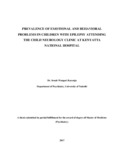| dc.contributor.author | Karanja, Serah W | |
| dc.date.accessioned | 2018-01-23T04:52:13Z | |
| dc.date.available | 2018-01-23T04:52:13Z | |
| dc.date.issued | 2017 | |
| dc.identifier.uri | http://hdl.handle.net/11295/102538 | |
| dc.description.abstract | Background: Epilepsy is a common neurological condition, with close to 80% of people living with epilepsy residing in developing countries. Approximately half of epilepsy in the population occurs during childhood. Epidemiologic studies internationally have shown a strong association between pediatric epilepsy and mental disorders. However, there is scarcity of research on this topic regionally and locally.
Aims: The purpose of this study was to determine the prevalence of emotional and behavioral problems in children with epilepsy on follow-up at the Kenyatta National Hospital neurology clinic and examine associated sociodemographic variables.
Methods: This was a cross-sectional descriptive study. Children with epilepsy aged between 6 to 12 years attending the Kenyatta National Hospital neurology clinic who met the study criteria were recruited, having obtained consent from their legal guardians. A sociodemographic questionnaire as well as the Child Behavior Checklist school age version (CBCL/6-18) was administered to the caregiver accompanying the child.
Data analysis: This was done using Stata (version 15). The overall prevalence of emotional and behavioral problems in childhood was determined by calculating the percentage of children with child behavior checklist score indicative of specific emotional and behavioral problems. Prevalence for specific morbidities was also calculated and reported separately for each condition. Multivariate analysis was used to determine sociodemographic factors which were significantly associated with emotional and behavioral problems. Results were presented in form of tables, charts, graphs and narratives.
Results: The overall prevalence of emotional and behavioural problems in children with epilepsy on follow-up at the KNH paediatric neurology clinic was 46.3%. Attention problems, aggressive behaviour, social problems and withdrawal/ depression were the four leading syndromes. For the internalizing and externalizing groupings of syndromes, the prevalence of internalizing syndromes was higher (10.2%) than the externalizing syndromes (6.8%). The prevalence of emotional and behavioural problems was significantly associated with age, diagnosis of mental disorder, types of antiepileptic drugs taken and reduced frequency of seizures.
Conclusion: There is a high prevalence of emotional and behavioral problems in children with epilepsy. Therefore, early screening for these problems, as well as integrated management consisting of pharmacotherapy, psychotherapy and psychoeducation would help to reduce their effect in these patients. | en_US |
| dc.language.iso | en | en_US |
| dc.publisher | University of Nairobi | en_US |
| dc.rights | Attribution-NonCommercial-NoDerivs 3.0 United States | * |
| dc.rights.uri | http://creativecommons.org/licenses/by-nc-nd/3.0/us/ | * |
| dc.title | Prevalence of emotional and behavioral problems in children with Epilepsy attending the child Neurology clinic at Kenyatta National Hospital | en_US |
| dc.type | Thesis | en_US |
| dc.description.department | a
Department of Psychiatry, University of Nairobi, ; bDepartment of Mental Health, School of Medicine,
Moi University, Eldoret, Kenya | |



